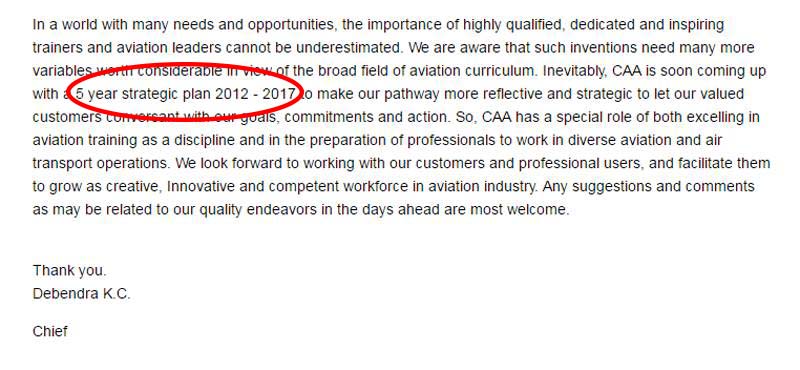Shocking! Civil Aviation Academy of Nepal fails at bottom
KATHMANDU: The state of Civil Aviation Academy of Nepal, founded to prepare specialised aviation personnel especially those needed for the control tower and fire-fighting, remains shocking, to say the least.
If the content on the official website is anything to go by, the page on "Message from the Academy Chief" is at least five-year stale as it continues boasting 'coming up with a five-year strategic plan 2012-2017', despite witnessing five chiefs since then.

Clearly, the placement at the Academy is considered lucrative in the Civil Aviation Authority of Nepal. Else, why would there be a beeline, asked a senior official at the Tribhuvan International Airport.
According to him, the profitable nature emerges out of the fact that the selection process for ab-initio air traffic controller trainees is out of bounds for the Public Service Commission and the Academy Chief continues to enjoy autonomy in this regards.
Since the number of trainees equals the number of vacant CAAN positions, the selection virtually guarantees a permanent position at the sole aviation regulator and high profile career like that of an airport manager, he added.
Though the Academy received the accreditation from the International Civil Aviation Organisation as an Associate Trainair Plus member in 2012, the fact that it could not attain a full membership even in five years speaks volumes of the Academy's academic accomplishments and the attitude of its academic community, another senior CAAN official admitted.
The attractiveness of the Academy, however, is evident from the fact that for certain courses, the steep fee paid by airline customers is split evenly between the instructors and the Academy.
"On the one hand, the instructors also enjoy an additional 25 per cent allowance for just being posted at the Academy; whereas, on the other, the Academy pursues the CAAN-approved policy of contracting much of the training tasks to other non-aviation training institutes of dubious nature, while the Academy instructors often sit idle," the official added.
The Academy is required to undergo, in line with ICAO stipulations, an annual audit by the CAAN head office-based inspectors before being allowed to conduct its business.
"The audit intended to ensure quality training continues to be sham as the consequences of an adverse audit report would hurt the inspectors more in their career as the chief is a twelfth level officer commanding influence in matters of foreign nominations and performance appraisal."
Besides, the inspectors are themselves products of the same Academy, he added.
Naturally, the Academy's end products-air traffic controllers and others, several of who now occupy key decisive positions at CAAN-remain of a dubious quality as the recent results have indicated.
"No wonder, the skies over Nepal are in a state of a perpetual mess: flight delays with no end in sight."
Meanwhile, the Nepal Air Traffic Controllers' Association claimed that the Academy’s products were working at national and international reputed organisations including the United Nations.
"On the ATS training, the CAA recruits fresh graduates especially from science or engineering or management field with minimum the second division. A proof of English language proficiency and medical fitness are the minimum requirement for application who then have to go through three written tests namely General Knowledge, Psychometric Assessment and English Tests," NATCA said in a statement, adding, "Thus, selected candidates will go for 50 per cent theory and 50 per practical (simulation) training. This training is focused on basic theories in aviation and acquiring skills to be qualified as an air traffic controller. Hence, this is basically a skill-based training. The trainees after pass out will be qualified to apply in positions of Air Traffic Controller (ATS Senior Officer)."






